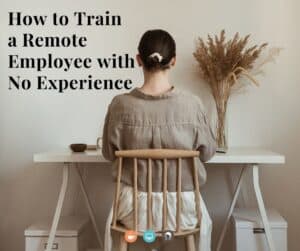How to Train a Remote Employee with No Experience

Hiring a remote employee with no experience can be a daunting task, but with the right approach, it can be highly rewarding. A remote job offers flexibility and access to a broader talent pool, but it also requires an effective onboarding process to ensure new hires are well-integrated and productive. In fact, an effective onboarding process can boost retention of new hires by 82%, according to a study by the Brandon Hall Group.
Establish Clear Expectations and Goals
Begin by clearly outlining job responsibilities and setting specific, measurable objectives that align with your organization’s broader goals. A well-defined job description and performance indicators provide the new hire with a clear understanding of what success looks like in their role. Regularly scheduled reviews help ensure alignment with team objectives and provide an opportunity for course correction if needed. It’s also beneficial to create a roadmap for the first few months, detailing key milestones and deliverables. This structured approach helps the remote employee prioritize tasks and stay focused on important outcomes.
Provide Comprehensive Onboarding Materials
Creating a centralized hub of resources is crucial for a new remote employee. Include company policies, procedural guides, and role-specific training manuals in this hub. This approach equips the employee with the necessary information and promotes self-sufficiency, reducing their reliance on constant guidance from managers or colleagues. Organize the materials in an intuitive manner, making it easy for the employee to find the information they need when they need it; make sure it is searchable so they can easily use keywords to get what they need. Offering video tutorials and interactive modules can also enhance the onboarding experience, providing visual and practical insights into their tasks. Additionally, an FAQ section addressing common queries can be very helpful in preventing any initial confusion.
Use Digital Tools for Effective Communication
Invest in reliable platforms like Slack, Zoom, or Microsoft Teams for instant messaging and video conferencing. It’s important to note that many companies, 47% to be exact, struggle with onboarding employees due to infrastructure access challenges, according to “2022: The Year of Access Report.” Address these challenges by ensuring that the remote employee has access to all necessary digital tools from day one. Schedule regular check-ins using these platforms to maintain a steady communication flow and keep the employee engaged. Additionally, setting up dedicated channels for different projects or topics can help streamline conversations and make it easier to locate important information. Encourage the use of shared digital workspaces for collaboration and document sharing to foster teamwork and transparency. Leveraging these tools effectively can bridge the gap between remote team members and create a cohesive working environment.
Offer Regular Training and Development Opportunities
To keep a remote employee motivated and evolving, provide regular training and development opportunities. This can include virtual workshops, webinars, and online courses tailored to the employee’s role. Encouraging employees to upskill not only enhances their current capabilities but also boosts their confidence. Establish a culture of learning by making training resources readily available and encouraging the employee to set personal development goals.
Provide Continuous Feedback and Monitor Progress
Establishing a consistent feedback loop is essential for the growth of a remote employee with no experience. Set up regular check-ins to discuss the employee’s progress, address any challenges, and provide constructive feedback. Utilize performance tracking tools to measure the employee’s achievements against their set goals and milestones. Celebrate successes to motivate the employee and acknowledge their efforts. Ensure that feedback is specific, actionable, and focused on both strengths and areas for improvement. Encourage a two-way dialogue where the employee feels comfortable sharing their thoughts and concerns. This open communication can lead to valuable insights and foster a sense of trust. Regularly review and adjust the training plan based on the employee’s development, ensuring it remains aligned with their evolving needs and role requirements.
